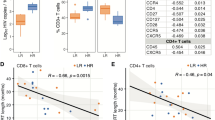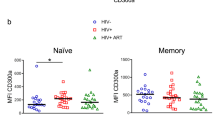Abstract
Active T cell suicide (apoptosis) is supposed to be involved in the CD4+ T cell depletion in the course of HIV infection. We investigated the expression of the apoptosis-related antigen Fas on CD4+ T cells from 25 HIV-positive individuals (CDC I-III) and 8 HIV-negative controls by two-colour flowcytometry. In addition, we evaluated: total CD4 count, HIV p24 antigen concentration in serum after immune complex dissociation, and clinical course of infection in HIV-positive individuals. We found a significant increase in mean Fas expression on CD4+ T cells from HIV-positive individuals compared to HIV-negative individuals (85.84±14.92% vs. 64.28±7.59%, P<0.001). Within the HIV-positive group the increase in Fas expression was correlated with the decline in CD4 count (r=−0.76, P<0.001), p24 antigen concentration in serum after immune complex dissociation (r=0.67, P<0.001), and CDC stage (r=0.73, P<0.001). The upregulation of Fas antigen on CD4 cells is associated with CD4 depletion and other virological and clinical marker of disease progression in HIV infection.
Similar content being viewed by others
Abbreviations
- AIDS :
-
Acquired immunodeficiency syndrome
- CDC :
-
Center of disease control
- CTL :
-
Cytotoxic T lymphocyte
- FasL :
-
Fas ligand
- HIV :
-
Human immunodeficiency virus
- MFI :
-
Mean fluorescence intensity
References
Amasaki Y, Kobayashi S, Takeda T, Ogura N, Jodo S, Nakabayashi T, Tsutsumi A, Fujisaku A, Koike T (1995) Up-regulated expression of Fas antigen (CD95) by peripheral naive and memory T cell subsets in patients with systemic lupus erythematosus (SLE): a possible mechanism for lymphopenia. Clin Exp Immunol 99:245–250
Ameisen JC, Capron A (1991) Cell dysfunction and depletion in AIDS: the programmed cell death hypothesis. Immunol Today 12:102–105
Ameisen JC, Estaquier J, Idziorek T, De Bels F (1995) The relevance of apoptosis to AIDS pathogenesis. Trends Cell Biol 5:27–31
Carbonari M, Cibati M, Cherchi M, Sbarigia D, Pesce AM, Dell'Anna L, Modica A, Fiorilli M (1994) Detection and characterization of apoptotic peripheral blood lymphocytes in human immunodeficiency virus infection and cancer chemotherapy by a novel flow immunocytometric method. Blood 83:1268–1277
Cohen P, Eisenberg R (1991) Lpr and gld: single gene models of systemic autoimmunity and lymphoproliferative disease. Annu Rev Immunol 9:243–269
Debatin KM, Fahrig-Faissner A, Enenkel-Stoodt S, Kreuz W, Benner A, Krammer PH (1994) High expression of APO-1 (CD95) on T lymphocytes from human immunodeficiency virus-1-infected children. Blood 83:3101–3103
Dennin RH, Dalhoff K (1995) HIV p24 antigen concentration in serum of 11 anti-HIV-1 positive patients before and after immune-complex dissociation: a study of a 5-year period. Clin Diag Virus 3:131–137
Ju S, Panka D, Cui H, Ettinger R, el-Khatib M, Sherr D, Stanger B, Marshak-Rothstein A (1995) Fas (CD95)/FasL interaction required for programmed cell death after T cell activation. Nature 373:444–448
Katsikis P, Wunderlich E, Smith C, Herzenberg L, Herzenberg L (1995) Fas antigen stimulation induces marked apoptosis of T lymphocytes in human immunodeficiency virus-infected individuals. J Exp Med 181:2029–2036
Kobayashi N, Hamamoto Y, Yamamoto N, Ishii A, Yonehara M, Yonehara S (1990) Anti-Fas monoclonal antibody is cytocidal to human immunodeficiency virus infected cells without augmenting viral replication. Proc Natl Acad Sci USA 87:9620–9624
Meyaard L, Otto S, Jonker R, Mijnster M, Keet R, Miedema F (1992) Programmed death of T cells in HIV-1 infection. Science 257:217–219
Miyawaki T, Uehara T, Nibu R, Tsuji T, Yachie A, Yonehara S, Taniguchi N (1992) Differential expression of apoptosis related Fas antigen on lymphocyte subpopulations in human peripheral blood. J Immunol 149:3753–3758
Murocacho C, Pantaleo G, Fauci A (1995) Analysis of apoptosis in lymph nodes of HIV-infected persons-intensity of apoptosis correlates with general state of activation of lymphoid tissue and not with stage of disease or viral burden. J Immunol 154:5555–5566
Oyaizu N, McCloskey T, Than S, Hu R, Kalyanaraman VS, Pahwa S (1994) Cross-linking of CD4 molecules upregulates Fas antigen expression in lymphocytes by inducing interferon-γ and tumor necrosis factor-α secretion. Blood 84:2622–2631
Rouvier E, Luciani M, Golstein P (1993) Fas involvement in Ca++-independent T cell-mediated cytotoxicity. J Exp Med 177:195–200
Yonehara S, Ishii A, Yonehara M (1989) A cell killing monoclonal antibody (anti-Fas) to a cell surface antigen co-downregulated with the receptor of tumor necrosis factor. J Exp Med 169:1747–1756
Wyllie AH (1985) The biology of cell death in tumors. Anticancer Res 5:131–136
Author information
Authors and Affiliations
Rights and permissions
About this article
Cite this article
Aries, S.P., Schaaf, B., Müller, C. et al. Fas (CD95) expression on CD4+ T cells from HIV-infected patients increases with disease progression. J Mol Med 73, 591–593 (1995). https://doi.org/10.1007/BF00196352
Received:
Accepted:
Issue Date:
DOI: https://doi.org/10.1007/BF00196352




